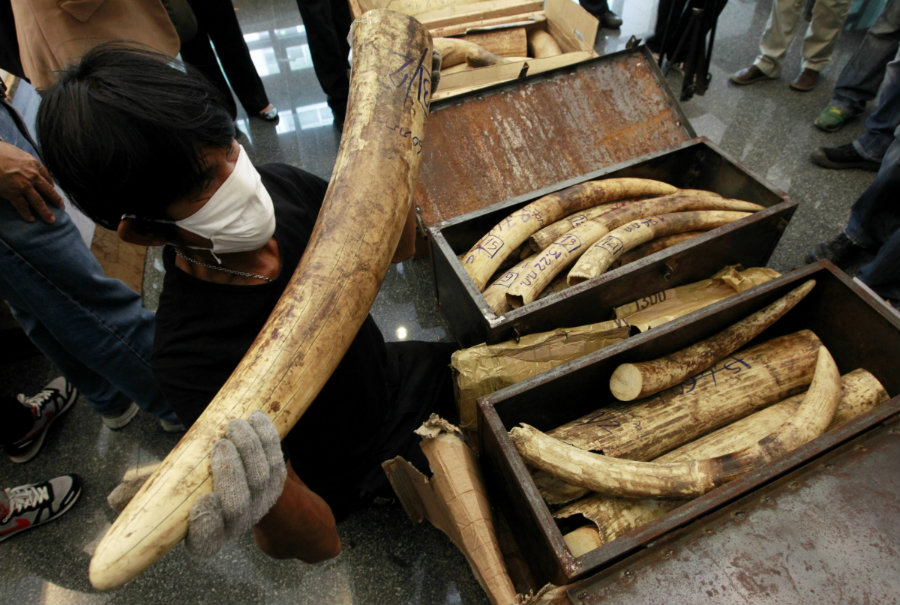Africa – An approximate thirty percent of all the savannah elephants in the continent have been killed over a seven-year period, between 2007 and 2014, according to the Great Elephant Census, the first extensive survey of elephant populations across the African continent. This translates to an estimated 144,000 elephants across 15 countries in the continent, mercilessly wiped out for their ivory tusks. Although it has long been accepted that elephants were in trouble because of poaching, there was never an exact data to support this fact.
The massive survey, accomplished with a fleet of small planes, shed light on the dramatic and troubling decline in elephant populations. The amount of elephants across the fifteen surveyed countries stands at approximately 352,271 animals in the wild. However, some countries, such as Northern Cameroon and Mali, have less than 300 individuals remaining.

The study found that in many countries the decline was of eight percent of the population every year, which means that the elephants are being killed faster than they can recover, leading to a reduction in its populations.
Although there had been previous census efforts, most were in a country by country basis over the years, which didn’t give a very clear picture of the status of elephant populations across Africa.
The Great Elephant Census is thus a groundbreaking, important event: the population across 15 countries paints a much more clear picture of the status of elephants, and the severe impacts of human activity, poaching in particular.
Mike Chase, founder of Elephants Without Borders and also the principal investigator of the Census, said: “Until we flew the aerial survey, no one had substantial evidence of the status of elephants, so how can you begin to conserve them when you don’t know how many there are or where they occur? We are armed with information now — we have solid, reliable estimates as a baseline and benchmark to shock people out of apathy.”
The elephant’s decline and the war against Ivory
Elephant populations were much higher in the past: an estimated one million animals back in the early twentieth century. Nonetheless, but as time passed and poaching, human-elephant conflicts, and environmental destruction worsened, their numbers began to decline at an alarming rate.
Anywhere from 300,000 to 600,000 individuals were left as many were killed between 1970 and 1990, over a twenty year period.
Following a trade ban executed by the Convention on International Trade in Endangered Species of Wild Flora and Fauna in 1989, some of the populations had managed to recover. However, this positive outcome, unfortunately, cut short by the rise of middle class in countries across the Far East.
In particular, the Chinese middle class tends to buy ivory products in a display of wealth, which has caused the world’s largest ivory market to flourish in recent years.
Yao Ming, ex-NBA star, is looking to change the people’s attitude towards ivory products, much like he did with shark fin soup, another product mostly bought to showcase one’s wealth.
Although the black market price for ivory had skyrocketed in twelve years, going from 120 dollars per kilogram in 2002 to 2,100 dollars per kilogram in 2014, a report by Save The Elephants, published last December, showed an almost fifty percent decline in the last two years.
The essential basis for conservation efforts
With the Census’ information, more and better efforts can be made to curb poaching and ivory trade. The decline caused by poaching accelerated after 2010, with no signs of slowing down. According to Chase, the best way to stop the crisis would be to end the ivory market and the demand for ivory products.
The census not only included living elephants: the spotters also took care to count the carcasses found, which provides vital information about the number of poached animals. An eight percent body ratio is high enough to cause a decline.

Cameroon had the worst rate, at a staggering eighty-three percent carcass ratio. The second worst is much more distant, with Mozambique at thirty-two percent, followed closely by Angola, with thirty percent and Tanzania, which had a twenty-six percent.
The estimated number of elephants counted in the census were of 148 in Northern Cameroon, 9,605 in Mozambique, 3,395 in Angola and 42,871 in Tanzania. These populations are at risk of extinction if no action is taken soon.
Good news among all the bad
However, not everything is bad news: some territories, such as South Africa, Botswana, Kenya, and Zimbabwe, among others, have stable or even growing populations.
This is a very encouraging data, especially since these good results come from the active preservation efforts made by local governments and organizations.
In particular, the W-Aali-Pendjari Complex, which includes Niger, Benin, and Burkina Faso has twice as many elephants than thirteen years ago, in 2003.
These findings were first unveiled at the World Conservation Congress held by the International Union for Conservation of Nature (IUCN) in Hawaii on Wednesday.
Most of the data obtained by the Census is being incorporated into the African Elephant Status Report, which will be used to shape future policies and decisions about elephant conservation and their future.
Source: Christian Science Monitor
